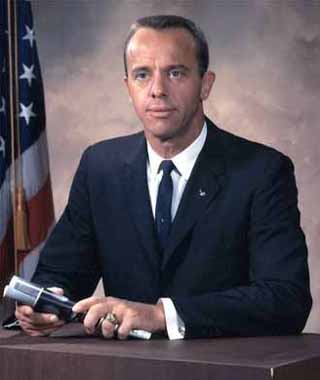This flight was not planned as an orbit, but as a suborbital ballistic trajectory. The Redstone could not reach the escape velocity required for an Earth orbit. The Americans only achieved this in February 1962 with the Mercury-Atlas 6 mission. Shepard reached an altitude of 187 km. After 15 minutes and 22 seconds, Freedom 7 landed safely in the Atlantic. This makes him the second person in space after Yuri Gagarin from the Soviet Union, who orbited the Earth once on April 12, 1961.
On the next two Mercury missions on July 21, 1961 (MR-4) and February 20, 1962 (MA-6), Shepard was involved as a liaison spokesman (Capcom).
For the final mission in the Mercury program, Mercury-Atlas 9, he was intended to be a backup pilot in case Gordon Cooper was unavailable, but the flight took place without any problems on May 15-16, 1963.
Shepard pushed for the last remaining Mercury spacecraft, Mercury 10, to be used for long-duration flight, with himself as pilot and Cooper as backup. He even had the spacecraft painted with the words “Freedom 7 II”, but NASA decided that all forces should be concentrated on the upcoming Gemini program, so Shepard did not get to orbit the Earth as he had hoped.
Alan B. Shepard was nominated as commander for the maiden flight of the Gemini spacecraft Gemini 3. He had already started training with Tom Stafford when he was diagnosed with a health problem in his left inner ear: Shepard suffered from Menière’s syndrome. Excessive fluid pressure in the inner ear leads to balance problems, dizziness and nausea, which impairs the ability to fly.
In early 1969, Shepard had inner ear surgery. In May he was certified as fully fit to fly again, allowing him to resume training as part of the Apollo program.
Shepard was initially slated to be commander of the Apollo 13 mission, scheduled to launch in April 1970, but NASA management pushed to give him more time to prepare because he had been absent from astronaut training for a long time. Therefore, Shepard was transferred to Apollo 14 along with Stuart Roosa and Edgar Mitchell.
Shepard was 47 years old when he flew Apollo 14, by far the oldest of the moon travelers. He was the first Mercury astronaut to reach the moon and would remain the only one.
Alan Shepard made history as the first golfer to walk on the moon. He took two golf balls with him to the moon, as well as a 6-iron, which he temporarily attached to a geological instrument. Because of the stiffness of the spacesuit, he had to punch with one hand. He missed the first ball at first, then moved it forward one or two meters in the second attempt. The third shot then hit, and with a fourth shot he was able to hit the second ball about 37 meters away.
On the following moon flights, Apollo 15 in July 1971 and Apollo 17 in December 1972, he served as a liaison spokesman (Capcom) in the flight management.
In June 1971 he resumed work as head of the astronaut office. On December 1, 1971, the U.S. Navy promoted him to rear admiral.
Shepard retired from NASA and the US Navy on July 31, 1974, handed over the management of the astronaut office to John Young and concentrated on his work as a businessman, which had already made him a millionaire during his astronaut days.
Together with the other Mercury astronauts and Betty, Gus Grissom’s widow, he founded the Mercury Seven Foundation in 1984, which awarded scholarships to needy students. In 1995, the foundation was renamed the Astronaut Scholarship Foundation and Shepard became president and chairman until he handed over both positions to former astronaut Jim Lovell in October 1997.
In 1996, Alan Shepard was found to have leukemia, from which he died in 1998 at the age of 74. His wife Louise, to whom he was married for 53 years, died just a month later. They left behind two daughters: Laura (* 1947) and Juliana (* 1951). The Shepards also raised their niece, Alice, who is sometimes referred to as a daughter.

